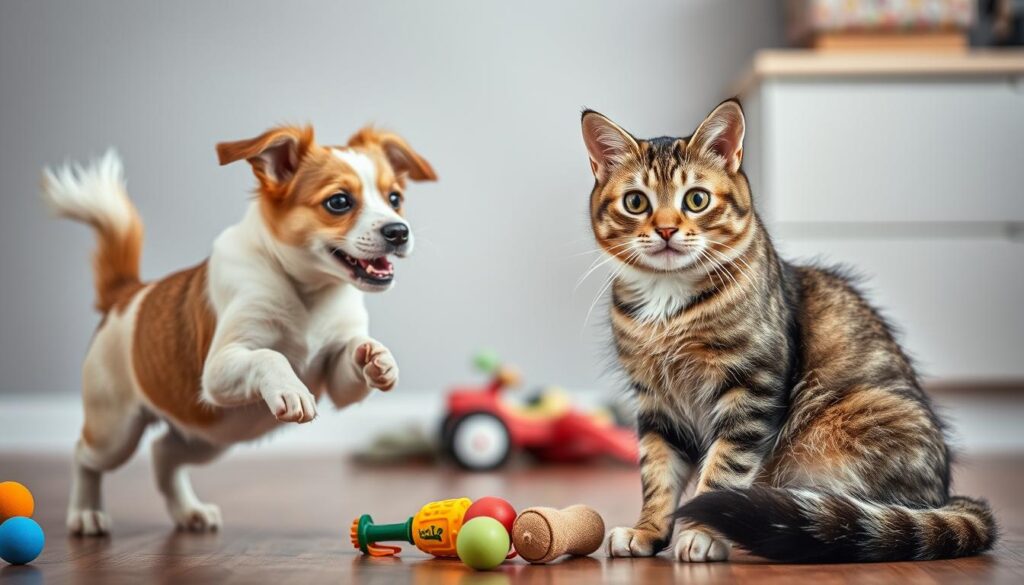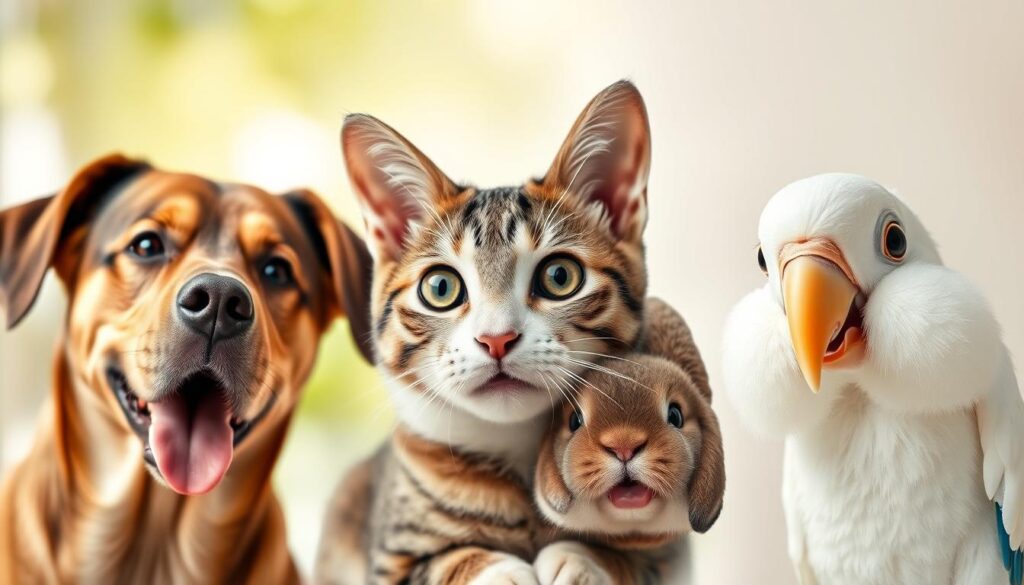Ever wonder what your furry friend is trying to say? Learning to read your pet’s body language can deepen your bond and understand their needs. This guide will dive into the complex world of pet communication. You’ll learn to interpret your pet’s nonverbal signals.

Key Takeaways
- Understand the science behind animal communication to better interpret your pet’s signals.
- Recognize the signs of happiness, stress, and anxiety in your pet to ensure their wellbeing.
- Discover the key differences in body language between dogs and cats for more effective communication.
- Learn how to build trust and strengthen the bond with your pet through body language recognition.
- Avoid common misinterpretations of pet signals and unveil the truth behind animal behavior.
But have you ever wondered, what secrets are your pet’s unique body language cues revealing about their inner world? By the end of this guide, you’ll know how to understand your pet’s nonverbal language. This will help you build a stronger, more loving relationship with them.
Why Understanding Pet Body Language Matters
Knowing how your pet communicates is key in animal behavior science. It helps you connect better with your pet, lower their stress, and solve behavioral problems. This knowledge is essential for a stronger bond with your pet. ( Pet’s Body Language )
The Science Behind Animal Communication
Our pets have complex ways to talk to us, thanks to thousands of years of evolution. They use their faces, ears, tails, and posture to share feelings and needs. These nonverbal signs tell us a lot about what they’re thinking and feeling.
Benefits of Reading Your Pet’s Signals
- Improved pet-owner bond: Understanding your pet’s body language helps you meet their needs. This builds a stronger, more trusting relationship.
- Stress reduction: Spotting stress or anxiety in your pet lets you ease their discomfort. This makes their environment calmer.
- Prevention of behavioral issues: Catching early signs of problems like aggression or separation anxiety helps. This way, you can start training early to avoid bigger issues.
Learning to read your pet’s body language is a skill that improves their life and your bond. By exploring animal communication and noticing the small details, you become a more caring and attentive pet owner.
“Observing and understanding your pet’s body language is the key to unlocking a deeper, more fulfilling relationship with your furry companion.” ( Pet’s Body Language )
Common Signs of Happiness and Contentment
It’s important for pet owners to know the signs of pet happiness. Understanding relaxed body language and positive pet behavior helps you see how your pet feels. This way, you can make sure they’re happy and well. ( Pet’s Body Language )
A happy pet usually has a relaxed posture. They might have a soft, loose body without any muscle tension. You’ll also see them resting comfortably, either on their side or in a natural pose.
- Loose, wiggly tail wags
- Gently squinting, half-closed eyes
- Ears that are relaxed and facing forward
- Playful, interactive behavior with you or other pets
A happy pet’s face shows it too. They often have a relaxed, open-mouthed expression without any tension. They might also lean into your touch or seek out affection, showing they’re happy and well. ( Pet’s Body Language )
| Pet Happiness Indicator | Description |
|---|---|
| Relaxed Posture | Soft, loose body with no visible tension or rigidity |
| Facial Expressions | Relaxed, open-mouthed expression with no signs of tension |
| Playful Behavior | Interactive, energetic play with you or other pets |
| Seeking Affection | Leaning into your touch and enjoying physical contact |
By watching for these pet happiness indicators, you can understand your pet’s feelings better. This helps ensure they’re happy and have a good life.

Recognizing Stress and Anxiety Signals
As a pet owner, it’s key to notice the signs of stress and anxiety in your pet. Knowing the physical signs, changes in behavior, and emergency signals is crucial. This knowledge helps you support your pet’s well-being. ( Pet’s Body Language )
Physical Manifestations of Stress
Physical changes are a clear sign of stress in pets. Look for signs like:
- Excessive panting or rapid breathing
- Dilated pupils
- Increased heart rate
- Tense or rigid body posture
- Trembling or shaking
These physicalpet stress symptomsshow your pet is feeling anxious. ( Pet’s Body Language )
Behavioral Changes During Anxiety
Your pet may also show behavioral changes when stressed or anxious. Watch for:
- Excessive grooming or licking
- Increased vocalization, such as whining or barking
- Hiding or avoidance behaviors
- Restlessness or pacing
- Loss of appetite or changes in eating habits
Thesewarning signsshow when your pet’spet mental healthmay be at risk.
Emergency Warning Signs
Stress and anxiety can sometimes lead to severe pet stress symptoms. If you see any of these, get vet help right away: ( Pet’s Body Language )
- Uncontrolled urination or defecation
- Aggressive or defensive behaviors
- Excessive drooling or foaming at the mouth
- Disorientation or lack of responsiveness
Thesewarning signsmay mean a medical emergency or need for professional help for your pet’sanxiety in animals.
By paying attention to your pet’s physical and behavioral signs, you can spot and help with their pet stress symptoms. This ensures their well-being and strengthens your bond with them. ( Pet’s Body Language )
Pet Body Language: Key Differences Between Dogs and Cats
Understanding your furry friends means knowing their body language. Dogs and cats communicate differently. Learning these differences helps you be a better pet owner. ( Pet’s Body Language )
Dogs show their feelings through their body. Wagging tails and perked ears mean they’re happy. But, a lowered head or tucked tail shows fear. Cats are more subtle. They use small signals to show what they need or feel.
| Dog Behavior | Cat Behavior |
|---|---|
| Wide, open-mouthed panting | Slow, deliberate blinking |
| Jumping, playful movements | Kneading with front paws |
| Tail wagging with a high, erect posture | Tail flicking or twitching at the tip |
| Ears perked forward and alert | Ears rotated back or flattened against the head |
Knowing how dogs and cats show their feelings helps you understand them better. This knowledge strengthens your bond with your pet. It also helps you meet their needs more effectively.

“The better we understand the language of our pets, the better we can meet their needs and strengthen our connection with them.”
Tail Positions and What They Mean
Your pet’s tail is a powerful tool for understanding their emotional state and intentions. Whether you have a canine companion or a feline friend, decoding the language of their tail can provide valuable insights into their well-being and behavior.
Dog Tail Communication
A dog’s tail is a reliable indicator of their mood and temperament. A wagging tail is often associated with happiness and friendliness. But the speed and position of the wag can reveal more nuanced information.
A slow, low wag may signal uncertainty or stress. On the other hand, a high, rapid wag can signify excitement or playfulness. A tucked-under tail, however, can suggest fear or submission. ( Pet’s Body Language )
Cat Tail Signals
Cats use their tails to communicate a wide range of emotions, from contentment to aggression. A gently swishing tail may indicate mild annoyance. While a twitching or lashing tail can signal a more intense emotion, such as anger or overstimulation.
A puffed-up tail can be a warning sign of potential aggression. Meanwhile, a tail held straight up can indicate confidence and curiosity.
Warning Signs in Tail Movement
It’s important to pay attention to any sudden or drastic changes in your pet’s tail position or movement. These can be signs of distress or impending aggression. A stiff, upright tail or a tail held high and tense may indicate a dog or cat that is feeling threatened or protective.
Rapid, erratic tail movements can also be a warning sign of an impending outburst or attack. By understanding the meaning behind your pet’s tail language, you can better anticipate their needs, prevent potential conflicts, and foster a deeper bond with your furry companion. Staying attuned to the subtle nuances of tail communication can be a valuable tool in the ongoing journey of pet ownership.
| Tail Position | Meaning in Dogs | Meaning in Cats |
|---|---|---|
| Wagging Tail | Happiness, Friendliness | Contentment, Curiosity |
| Tucked-Under Tail | Fear, Submission | Anxiety, Insecurity |
| Stiff, Upright Tail | Aggression, Territorial Behavior | Aggression, Defensive Posture |
| Puffed-Up Tail | N/A | Warning, Potential Aggression |
Facial Expressions and Ear Movements
Learning to read your pet’s nonverbal signs can give you a peek into their feelings and health. Their facial cues and ear positions are especially telling. By grasping these subtle signals, you can connect better with your pet and meet their needs. ( Pet’s Body Language )
Dogs and cats show their feelings through their faces. A calm, slightly open mouth usually means they’re happy. But a tight, closed mouth might show they’re stressed or uncomfortable. Raised eyebrows can mean they’re curious or worried, while a furrowed brow often shows concern or fear.
Your pet’s ear position also tells a story. Ears that point up and forward usually mean they’re interested or alert. But if their ears are flat or tucked back, they might be scared, angry, or feeling submissive. Ears that sit sideways often show they’re feeling relaxed and at ease. ( Pet’s Body Language )
| Facial Expression | Ear Position | Emotional Meaning |
|---|---|---|
| Relaxed, slightly open mouth | Perked, forward-facing | Contentment, relaxation |
| Tense, closed mouth | Flattened or pinned-back | Stress, discomfort |
| Raised eyebrows | Sideways | Curiosity, concern |
| Furrowed brow | Pinned-back | Worry, apprehension |
By watching and understanding your pet’s facial cues and ear positions, you can learn a lot about their feelings and health. This knowledge helps you strengthen your bond, care for them better, and meet their needs more effectively. ( Pet’s Body Language )

“Understanding your pet’s body language is the key to a deeper, more fulfilling relationship.”
Understanding Territorial and Defensive Behaviors
As pet owners, it’s key to spot the signs of territorial behavior and defense in our pets. These signs, like marking and claiming space, come from a natural urge to guard their home and personal space.
Marking and Space Claims
Pets may mark their territory by urinating or scratching. Cats, especially, mark their space with scent glands. Dogs might use urine marking or show aggression to claim their territory and show others they’re there. ( Pet’s Body Language )
Protective Postures
When pets feel threatened or their space is invaded, they may show defensive postures. This can include raised hackles, stiff bodies, and direct eye contact. In extreme cases, they might growl or bare their teeth to protect themselves and their territory.
Knowing about pet territorial behaviors and animal defense mechanisms helps create a safe space for your pet. It also prevents conflicts with other animals or people. By recognizing space claiming and protective pets, you can manage these behaviors. This builds a better relationship with your pet.
| Behavior | Explanation | Potential Triggers |
|---|---|---|
| Marking | Pets may urinate or scratch to mark their territory and assert dominance. | New people, animals, or objects in the pet’s environment |
| Space Claiming | Pets may use aggressive posturing or body language to claim and defend their personal space. | Perceived threats to their safety or resources |
| Protective Postures | Pets may adopt defensive stances, like raised hackles or stiffened bodies, to deter potential intruders. | Perceived threats to themselves or their territory |
Building Trust Through Body Language Recognition
Creating a strong bond with your pet is more than just caring for them. It’s about understanding their way of talking to you – through body language. By learning to read and respond to their signals, you build trust. This strengthens the bond between you and your pet.
Positive reinforcement is key to building trust through body language. When you get your pet’s signals right and respond well, you boost their trust in you. This creates a cycle of trust. Your pet feels safe and secure, leading to more open communication.
- Observe your pet’s posture, facial expressions, and movements to gauge their emotional state and needs.
- Respond with calm, gentle gestures and tone of voice to show your pet you understand and can meet their needs.
- Use positive reinforcement techniques, such as treats or praise, to reward your pet for exhibiting desired behaviors.
Improving your pet communication skills helps build a strong bond of trust and understanding. This connection, based on the animal-human bond and pet trust building, makes your relationship richer. It leads to a harmonious and fulfilling life together.
“The better you understand your pet’s body language, the stronger the bond you will share.”
Common Misinterpretations of Pet Signals
As pet owners, we often see our pets through our own cultural lens. This can lead to common misunderstandings about how animals communicate. Let’s look at some of the most common pet behavior myths and how cultural differences in pet communication affect our understanding of misunderstood animal signals. ( Pet’s Body Language )
Myths About Animal Body Language
Many think a wagging dog tail always means happiness. But, a fast wag can also show stress, fear, or aggression. A cat’s purr is often seen as happiness, but it can also be a sign of stress or a way to get attention.
Cultural Differences in Pet Communication
Understanding pet signals can be tricky because of cultural differences. For instance, in some cultures, looking a dog in the eye is seen as a challenge. In others, it’s a sign of love. The meaning of certain body language, like ear position or fur standing up, can also vary by culture.
It’s important to understand these differences to build a strong bond with our pets. By questioning our assumptions and looking at things from different cultures, we can better support our furry friends. ( Pet’s Body Language )
“The more we learn about the complex nature of animal communication, the better we can empathize with our pets and meet their emotional needs.” ( Pet’s Body Language )
Conclusion
Understanding your pet’s body language is key to a strong bond with them. Knowing how they feel, whether happy, stressed, or needing space, helps you communicate better. This way, you can meet their unique needs. ( Pet’s Body Language )
Seeing the value in animal communication is the first step to being a better pet owner. By noticing their small signals and learning about their body language, you can grow closer. This also makes sure your pet is happy and healthy. ( Pet’s Body Language )
Learning about pet body language is a lifelong journey. Keep learning, watching your pet, and changing how you act as they grow. With effort and an open mind, you’ll understand animal communication better. This will make your relationship with your pet even stronger and more rewarding.
FAQ
What is the importance of understanding pet body language?
Knowing your pet’s body language is key to a strong bond. It lets you understand their needs and feelings. This way, you can care for them better.
How can understanding pet body language benefit me and my pet?
Getting your pet’s body language helps strengthen your bond. It reduces stress and prevents bad behavior. You’ll know when they’re happy or upset, helping you meet their needs.
What are some common signs of happiness and contentment in pets?
Happy pets show relaxed postures and soft faces. They might wag their tails or play. They also seek affection and seem calm.
How can I recognize stress and anxiety signals in my pet?
Look for tense postures and big pupils in stressed pets. They might pant a lot or tremble. Changes in behavior, like hiding or yelling, also show distress.
What are the key differences in body language between dogs and cats?
Dogs and cats communicate differently. Dogs wag their tails to show joy, while cats use theirs to show irritation. Knowing these differences helps avoid misunderstandings.
How can I use my understanding of pet body language to build trust and strengthen the bond with my pet?
Responding to your pet’s cues with empathy builds trust. Use positive reinforcement and respect their boundaries. Adjust your behavior to match theirs.
What are some common misconceptions about pet body language?
A wagging tail doesn’t always mean a happy dog. The tail’s speed and direction can show different feelings. Cultural views on pet behavior can also lead to misunderstandings.
IMPORTANT ADDITIONS
Edited on , 10 NOV ,2024
Read more articles : https://petsfeeling.com/blog-2/
social media :
facebook : https://www.facebook.com/PetsFeeling0/
tiktok : https://www.tiktok.com/@pets.feeling
instagram : https://www.instagram.com/pets._.feeling/
youtube : https://www.youtube.com/@Pets-Feeling

